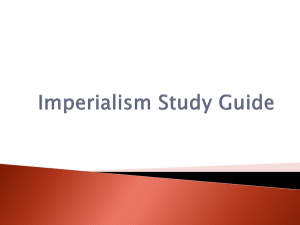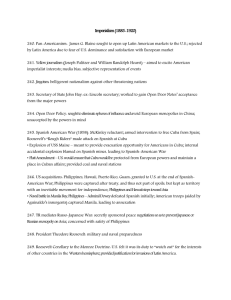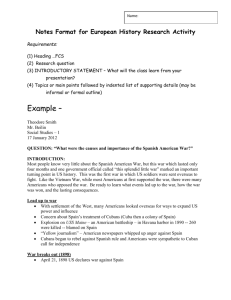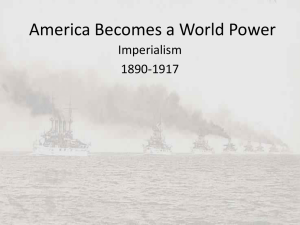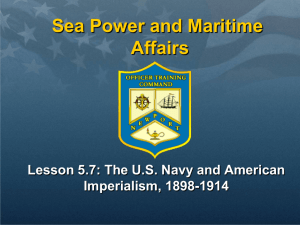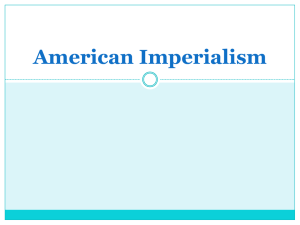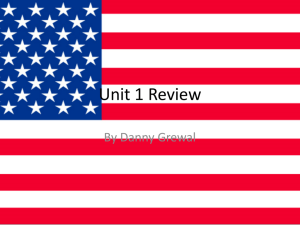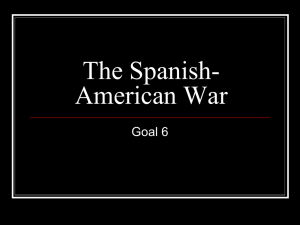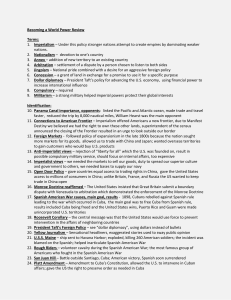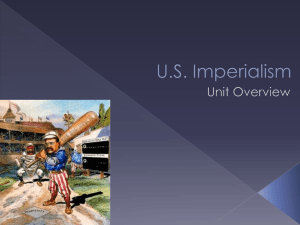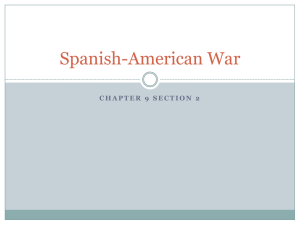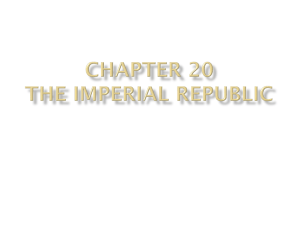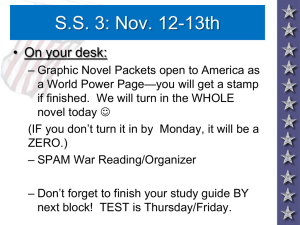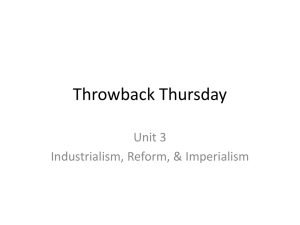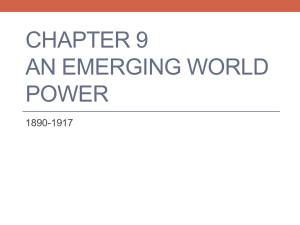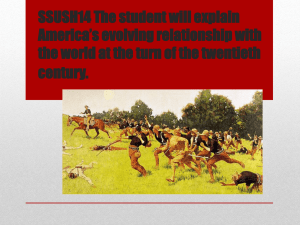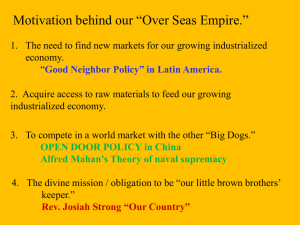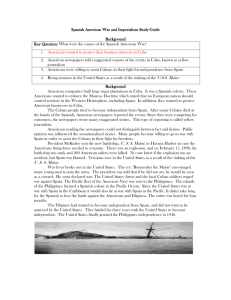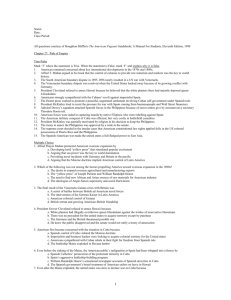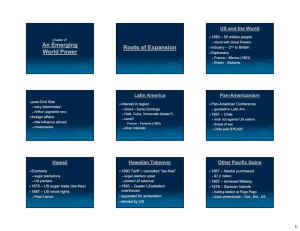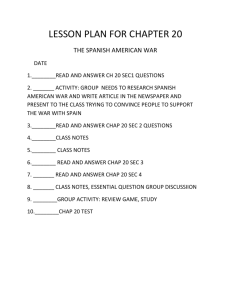America Becomes an Imperial Power
advertisement
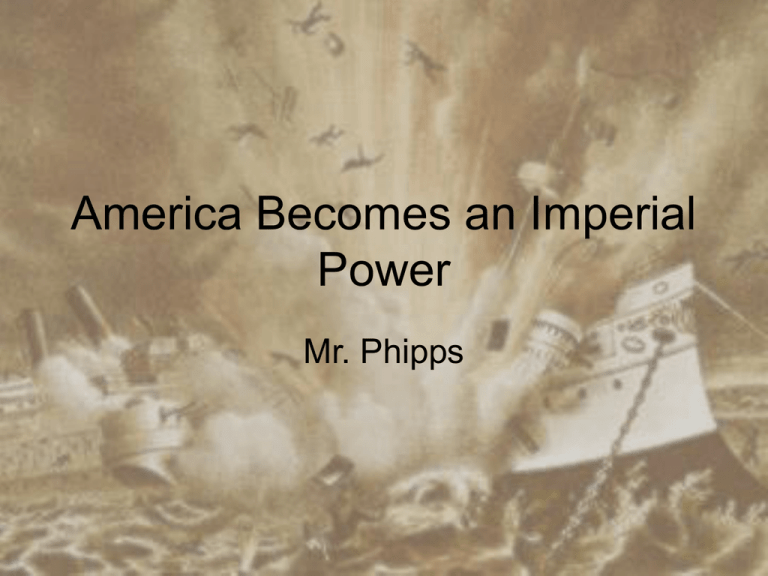
America Becomes an Imperial Power Mr. Phipps I. The Turning Point The Spanish American War (18981899) Background Spanish Oppression of Natives • Years of poverty, cruelty, brutality, deprivation • Had taken native land • Cubans revolted (1895) and torched sugar plantations, resulting in further brutality by Gen Weyler • Americans intervened only to get better price on sugar America’s Foreign Policy A Shift in Policy for the U.S. • Needed to enforce the Monroe Doctrine--to protect the Western Hemisphere from foreign aggression • Needed to compete with the European imperialism • Needed new ports to facilitate trade with new markets The Great White Fleet Theodore Roosevelt, Asst. Sec. of Navy • Initiated first peace-time mobilization • Refaced navy to include battleships, speedboats, gunships, and support carriers • All naval vessels under mechanical power--fuel, coal, electricity • All vessels made of steel • All vessels continuously fueled and ready II. The U.S.S. Maine The War Starts U.S.S. Maine • Sent to Cuba to monitor Cuban militarism (spy on the Spanish) • Feb. 15, 1898, the U.S.S. Maine explodes in Havana Bay • Cause unknown, but Spanish are suspected of planting a bomb • 260 American sailors died • Resulted in public outcry and demand for war Modern evidence suggests that faulty wiring, combined with rust and proximity to ammunition caused the explosion Yellow Journalism William Randolph Hearst and Joseph Pulitzer • Competed in selling newspapers • Focused on sensationalist reporting – Often untrue, exaggerated stories – National Enquirer style headlines – Flashy, violent pictures • Published private De Lome (Spanish ambassador) that criticized the President • Argued for war, as it would sell more papers A Splendid Little War The War in the Philippines • Spain’s empire included the Philippines, Cuba, and a series of islands in the Pacific • Roosevelt sent Great White Fleet to the Philippines to prevent Spanish naval mobilization and destroy its fleet • Admiral Dewey, head of the naval fleet, destroyed Spain’s navy within days of its arrival The War in Cuba • American military unprepared and untrained – Army was given woolen underwear – No military leadership with experience – Food rations were tainted, canned meat gave soldiers food poisoning – Dysentary, malaria, and yellow fever were common – Gen. Shafter, the ranking general, had gout, was grossly obese, and had to be carried to battle • Major Battles: Battle of Guarisimas and Battle of San Juan Hill The Results of the Spanish American War • The U.S. “won” islands from Spain – Cuba, The Philippines, Puerto Rico • The U.S. gained control of Pacific sea trade lanes • The U.S. improved reputation for helping people become democratic • The U.S. became an internationally recognized military and political power III: American Involvement in the World Alaska (1867) • “Seward’s Folly” • Wanted as a buffer from Russia • Considered idiotic because of its apparent uselessness • Bought for $7.2 million • Would yield petroleum, oil, timber, and silver Hawaii (1893) • Queen Liliuokalani forced to abdicate her throne to husband, a puppet • American sugar plantations forced the revolution in order to dictate price of sugar • American gov’t supported it because it wanted Pearl Harbor as strategic port • Considered an egregious abuse of power • Started a huge Hawaiian fashion in mainland Japan (1908) • TR’s Nobel Peace Prize – Result of mediating the RussoJapanese War – America chosen to arbitrate international dispute – Neither side happy with result, forcing migration wave in 1906 • Gentleman’s Agreement – American government could dictate Japanese immigration • Root-Takahira Agreement – U.S. forced integration in San Francisco schools, because of racial discrimination following immigration • Background China – Needed a balance to industrializing power of Japan and Russian expansion – China remained decentralized, agricultural, and “primitive” – Chinese had immigrated to the U.S. to help build railroad – Chinese Exclusion Act (1882)--banned Chinese immigration The Open Door Policy (1899) • Issued by John Hay (U.S. Sec. of State) • Urged European powers to carve up China into “spheres of influence” • Allow free trade and open exploitation by all European powers • Maintain peace and balance power around the world The Boxer Rebellion (1900) • “The Peaceful Harmonious Fists” • Student organization protested the incursion of missionaries and European businessmen • Called them “foreign devils • Killed over 200 missionaries and diplomats in Beijing (Peking) Panama (1904) • Spanish-American War highlighted need for isthmian canal – Deploy navy from east to west – Move cargo/product from east to west – Speed movement • Possible canal sites: – Panama: shorter, easier to dig, wanted independence from Colombia, but occupied by France – Nicaragua: longer, in volcanic area, had Congressional and contractor support “Gunboat Diplomacy” • U.S. supported Panamanian Revolution • Broadened Monroe Doctrine to facilitate democracy around the world • Gained control of the Canal Zone in the Hay-BunauVarilla Treaty Building the Canal • Construction started in 1904 • Required – Eliminating malaria, dysentery, and yellow fever – Moving machinery through mud – Provide living space for workers – Build a 50 mile long series of locks, artificial lakes, and communication links The Turning Point • The Spanish-American War was the culmination of a debate in the U.S. to pursue an imperialist policy • The U.S. became a leading international political, diplomatic, and military leader in the world • The U.S. forced to take care of colonial possessions: The Philippines, Puerto Rico, Cuba, and Panama – – – – Forced to decide if American laws govern them Forced to take care of rebuilding infrastructure Forced to stop internal rebellion Earned criticism for treatment and cost of policy
